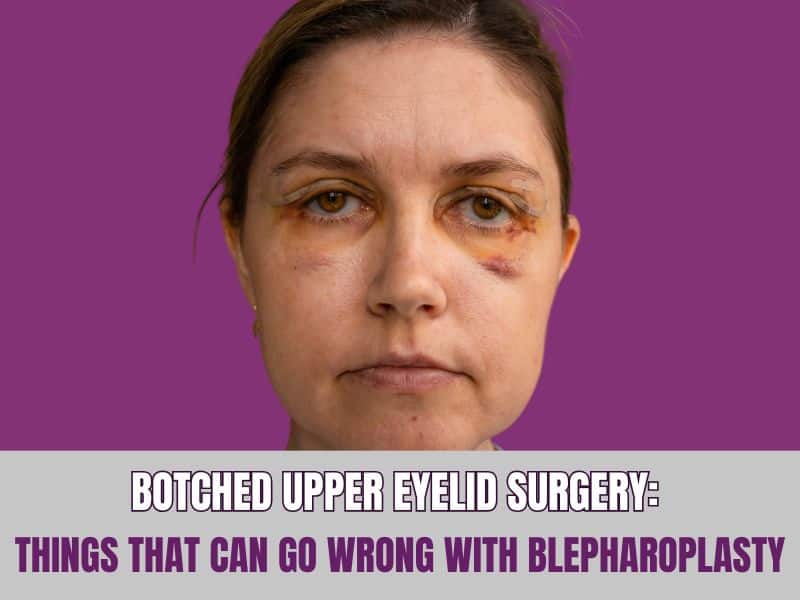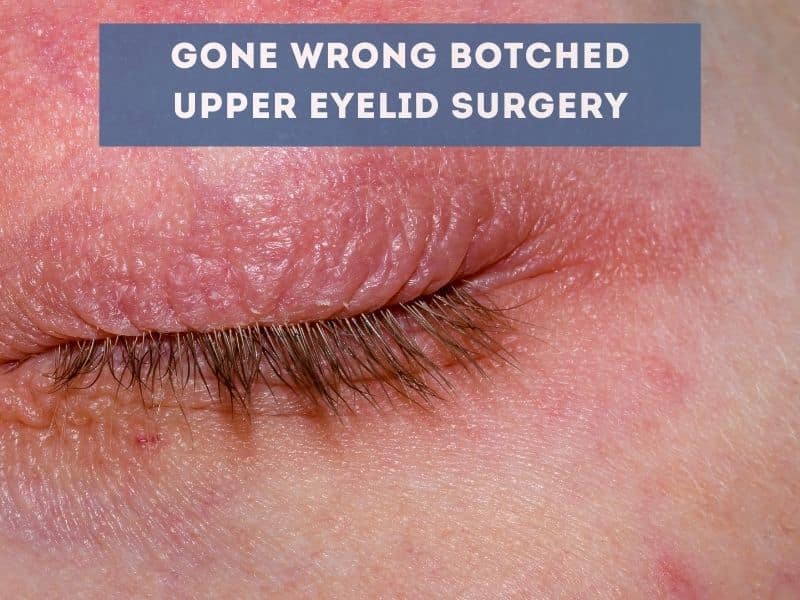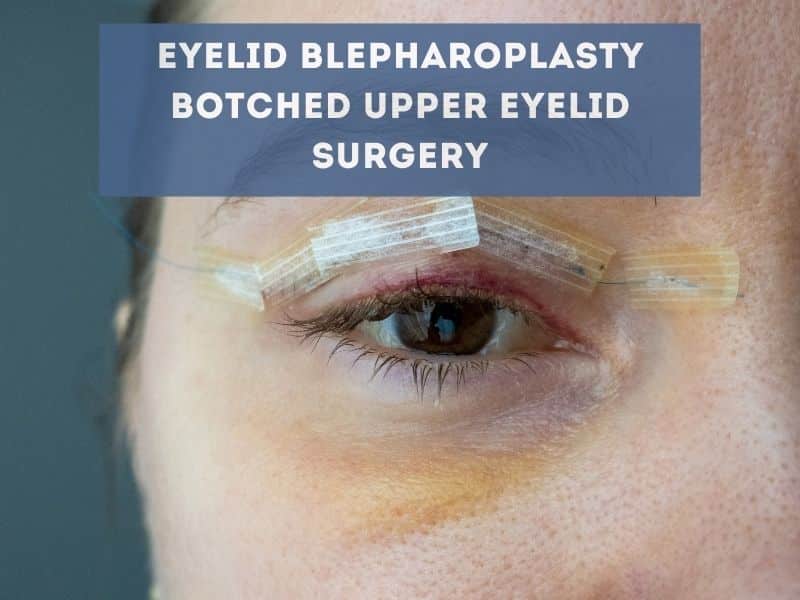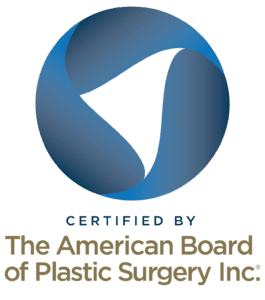
Blepharoplasty is a safe and effective plastic surgery that can improve the following conditions:
- Sagging or loose skin around the upper eyelids, which can also affect vision
- Puffiness in the upper and lower lids caused by migrating fat deposits
- Bags under the eyes
- Drooping lower eyelids that expose the whites of the eyes
Many people complain of sagging skin and eye bags as they age, and the delicate skin around the eyes does naturally stretch and get looser over time.
While Botox and dermal fillers can slightly improve sagging skin, only an eyelid lift offers a long-term solution to tired-looking eyes and eye bags.
As long as you choose a board-certified, reputable plastic surgeon, complications or a botched upper eyelid surgery rarely occur. Still, if you are considering Houston blepharoplasty to improve your appearance, it’s important to know the possible risks. Continue reading to learn more.
Blepharoplasty Procedure Overview
Cosmetic eyelid surgery can be performed on the upper or lower eyelid. The surgeon makes an incision along the upper eyelid crease for an upper eyelid lift to remove loose and sagging skin.
Next, they remove extra fat, muscle, and skin, and close the incision. This surgical procedure helps to fix a droopy upper eyelid, also known as upper eyelid ptosis. The scar is hidden in the natural fold of the upper lid and is practically invisible after it heals.
Lower eyelid surgery may be needed if sagging skin exposes too much of the white of the eye or if you have bags under the eyes. Lower eyelid surgery requires an incision below the lower eyelashes or on the inside of your eyelid. The surgeon then removes or moves fat from the eye bags and removes excess skin.
They also may tighten the tendons and muscles controlling the lower lids if necessary.
Droopy Eyelid Surgery Recovery
Even the most successful surgical procedure will require several weeks of recovery and healing. In the short term, expect these side effects from blepharoplasty:
- Mild to moderate pain: The most severe pain is in the first three or four days, but it will fade
- Swelling and bruising around the upper and lower lids, which can last up to 14 days
- Tight eyelids
- Dry eyes
- Burning or itching eyes
Your eyes also may tire faster for a few weeks. These side effects are normal and should fade after three or four weeks.
Talk to your doctor if you notice excessive swelling and bruising or severe pain.
What Can Go Wrong With Blepharoplasty?
Again, a botched eyelid procedure rarely happens, and revision surgery is rarely needed (let alone multiple eyelid surgeries) to correct problems. The results are usually excellent when a skilled plastic surgeon performs an eyelid lift. Still, every surgery does have the possibility of complications, and you want to avoid a botched procedure as fixing botched upper eyelid surgery can be extremely difficult.
Ultimately with blepharoplasty, the following are the most common issues when a botched eyelid surgery occurs:
 Too Much Fat Is Taken Out
Too Much Fat Is Taken Out
Excess skin on the upper eyelids is a common issue that plastic surgeons must contend with. Unfortunately, it’s possible a plastic surgeon could remove too much fat from the upper or lower lids, resulting in a condition called ‘hallowing.’
This hollow upper eyelid problem could make your eyes look startled or too awake instead of young and fresh. Fortunately, a skilled, experienced surgeon can avoid this issue.
You can usually avoid this problem by carefully reviewing before and after eyelid surgery photos for previous patients of the plastic surgeons you are considering. You want to see a natural-looking, alert result without excess skin, not a look that makes the individual appear like they were just frightened by a scary movie.
Lower Lid Is in Wrong Position
Lower eyelid surgery must be exact for the best result. Mere millimeters make all the difference in how you look.
Less experienced plastic surgeons may put the lower eyelid in the wrong position, making the eyes look different sizes. Or, in a botched eyelid surgery, someone may end up looking like they are squinting all the time.
See Also: Are You Awake During Blepharoplasty?
Excessively Bruised Eyes
All patients react differently to surgery, and you may bruise more than others. A highly skilled surgeon can often avoid some post-op bruising if they have a delicate approach.
Still, an aggressive eyelid lift can leave a lot of residual bruising around the eyes and eyelids. Most bruising will heal after several weeks, but the less bruising, the better.
Before surgery, verify your surgeon has extensive experience with blepharoplasty to ensure you’ll have the best result with minimal bruising.
Eyes Are Asymmetrical
Occasionally, a patient’s eyes will not match after the procedure. This problem can happen if the tissues are too reactive to the surgical approach or if the eyes react differently to the healing process.
Fortunately, an asymmetrical result may be fixed with a revision procedure after you are fully healed. While you may want to have the issue addressed right away, it’s essential that the tissue around the eyes fully heals before attempting another procedure.
You Cannot Close Your Eyes Entirely
Possibly the most significant risk of an eyelid lift is not being able to close your eyes thoroughly after surgery. This is a severe complication that can happen if the surgeon removes too much skin or places incisions in the wrong spot.
This is a frequent problem with inexpensive eyelid lifts done overseas, so use extreme caution before going this route.
When too much skin is taken out during surgery, it can be challenging to close the eyes. In addition, it is very challenging to repair after the skin is eliminated; it cannot be sewn back in place.
The eyelids have some of the thinnest and most delicate skin, so the surgeon should be conservative in the first procedure. If necessary, they can always do a follow-up procedure to remove more tissue.
Blepharoplasty is usually effective at addressing loose skin and eye bags on the upper and lower lids. Make sure you do your homework on the surgeon to ensure they are a skilled professional who can deliver fantastic results.
How to Choose the Right Surgeon for Blepharoplasty
To minimize the risks of complications and ensure optimal results, follow these steps when selecting a plastic surgeon:
1. Look for Board Certification – Ensure your surgeon is certified by the American Board of Plastic Surgery (ABPS) or a similar recognized board.
2. Review Before and After Photos – Examining a surgeon’s past work can help you assess their skill and ability to achieve natural-looking results.
3. Read Patient Reviews – Honest feedback from previous patients can give insight into their experiences, outcomes, and satisfaction with the procedure.
4. Schedule a Consultation – Meet with the surgeon to discuss your goals, ask about their experience, and evaluate their approach to safety and precision.
5. Ask About Their Revision Rate – A good surgeon should have a low rate of revision procedures due to initial surgical errors.
Lastly, doing personal research and choosing a qualified blepharoplasty surgeon can help minimize these risks.
Frequently Asked Questions
How long does it take to recover from blepharoplasty?
Most patients experience swelling and bruising for up to 14 days. Full healing can take several weeks to a few months.
 Will my scars be visible after blepharoplasty?
Will my scars be visible after blepharoplasty?
No, the incisions are placed in the natural folds of the eyelid, making them nearly invisible once healed.
Can I wear makeup after eyelid surgery?
You should wait at least two weeks before applying eye makeup to prevent infection and irritation.
How can I reduce swelling and bruising after surgery?
Applying cold compresses, keeping your head elevated, and following your surgeon’s aftercare instructions can help reduce swelling and bruising.
What should I do if I experience complications?
If you notice excessive swelling, severe pain, or difficulty closing your eyes, contact your surgeon immediately.
How can I prepare for blepharoplasty?
Follow your surgeon’s pre-op instructions, which may include stopping certain medications, avoiding smoking, and arranging for post-surgery care.
What are the risks of blepharoplasty?
Potential risks include infection, dry eyes, scarring, asymmetry, or difficulty closing the eyes. Choosing a skilled surgeon minimizes these risks.
Request a Houston Blepharoplasty Consultation
Want to know how to qualify for eyelid surgery? Had your upper eyelid surgery botched and need revision surgery? Please set up a consultation with Dr. Ashley Steinberg today. Dr. Steinberg can fix botched upper eyelid surgery or perform blepharoplasty for the first time.
References
- Eyelid Surgery Recovery. (2021). Accessed at https://www.verywellhealth.com/eyelid-surgery-recovery-2709807
- Blepharoplasty Overview. (n.d.). Accessed at https://www.mayoclinic.org/tests-procedures/blepharoplasty/about/pac-20385174
- Eyelid Lift Overview. (n.d.). Accessed at https://www.webmd.com/beauty/cosmetic-procedures-eyelid-surgery



 Too Much Fat Is Taken Out
Too Much Fat Is Taken Out Will my scars be visible after blepharoplasty?
Will my scars be visible after blepharoplasty?








